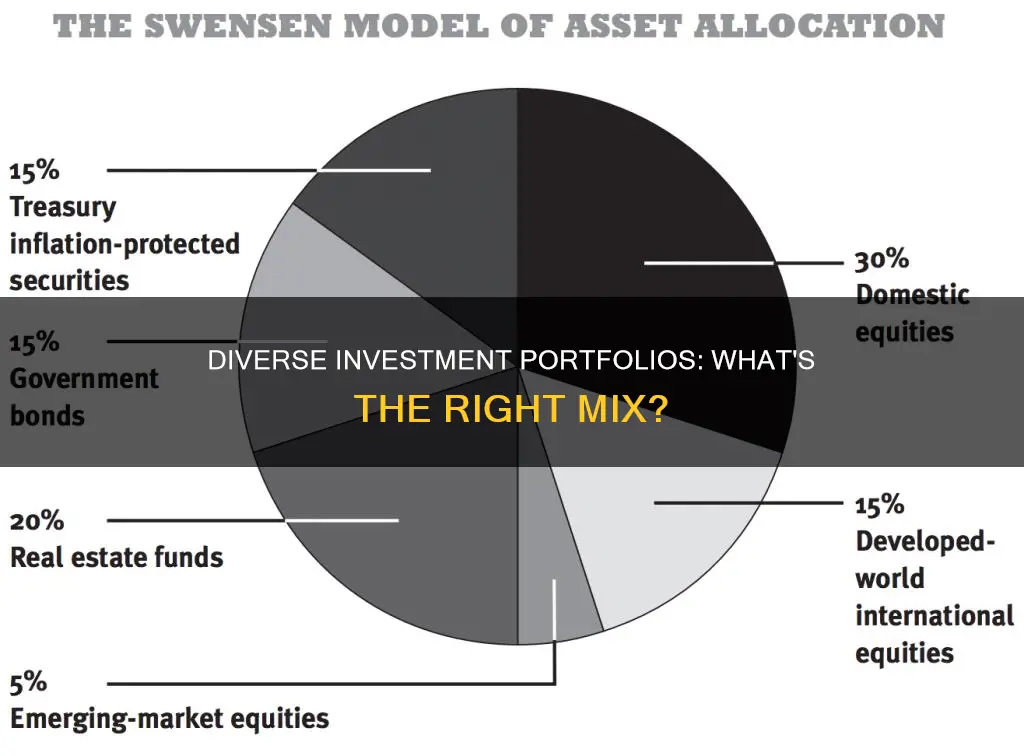
Diversification is a common investment strategy that involves spreading investment funds across a range of assets to reduce the risk of market volatility. A diversified portfolio typically includes a mix of asset classes, such as stocks, bonds, and cash or cash equivalents, as well as diversification within and beyond these asset classes. This approach helps to lower the overall risk of the portfolio while increasing the potential for overall return.
By diversifying across asset classes, investors can benefit from the performance of various sectors and industries. Diversification within asset classes involves investing in a variety of stocks, such as tech stocks, energy stocks, and healthcare stocks, as well as different types of bonds. Diversification beyond asset classes may include investing in real estate, commodities, gold, cryptocurrencies, and alternative investments.
It's important to note that diversification may look different for each investor, depending on their risk tolerance, investment horizon, and other factors. Additionally, while diversification can reduce risk, it cannot eliminate it completely. Investors need to be mindful of both market risk and asset-specific risks when constructing their portfolios.
| Characteristics | Values |
|---|---|
| Number of investments | At least 25 |
| Investment types | Stocks, bonds, cash, commodities, real estate, cryptocurrencies, foreign assets |
| Industries | Tech, energy, healthcare, and others |
| Countries | Domestic and international |
| Risk profiles | High, medium, and low |
| Correlation | Low or negative |
| Market capitalisation | Large, mid, and small caps |
| Investment styles | Growth and value |
What You'll Learn

Diversify across asset classes
Diversification across asset classes is a crucial aspect of building a robust investment portfolio. Here are some detailed guidelines on how to achieve effective diversification across different asset classes:
Equities (Stocks)
Stocks represent ownership in a company, and they are a fundamental component of a diversified portfolio. It is recommended to hold a diverse range of stocks across various sectors, such as technology, energy, healthcare, consumer discretionary, consumer staples, financials, and more. Diversifying across sectors helps protect against industry-specific risks. Additionally, consider investing in a mix of large-cap, small-cap, dividend, growth, and value stocks. Large-cap stocks tend to be more stable, while small-cap stocks offer higher growth potential. Dividend stocks distribute a portion of the company's profits to shareholders, and value stocks are considered undervalued by the market.
Fixed Income (Bonds)
Bonds are loans made to a company or government, and they play a crucial role in reducing portfolio volatility and overall risk. By investing in bonds, you are lending money to these entities and earning interest in return. Diversification within the fixed-income asset class can be achieved by investing in bonds with varying maturities, credit qualities, and durations. Consider both government and corporate bonds to balance your portfolio.
Cash and Cash Equivalents
Cash and cash equivalents, such as savings accounts, money market funds, and certificates of deposit (CDs), are essential for diversification and risk management. While they may not offer high returns, they provide liquidity and stability. Cash reserves can be utilized to take advantage of investment opportunities during market downturns or to buffer against unexpected expenses.
Real Assets (Property)
Including real assets, such as real estate, in your portfolio can further enhance diversification. One way to invest in real estate is through Real Estate Investment Trusts (REITs), which own income-producing commercial properties. REITs have historically increased total portfolio returns while reducing volatility.
Other Asset Classes
In addition to the core asset classes mentioned above, you can explore alternative investments such as commodities (including precious metals), cryptocurrencies, and foreign assets. These non-traditional asset classes can provide diversification benefits and potentially boost returns.
Remember, the key to successful diversification across asset classes is to ensure your portfolio is well-balanced and not overly concentrated in any single asset class or sector. Diversification aims to reduce risk and smooth out returns, providing long-term benefits and helping you stay on track with your investment goals.
Balancing Your Investment Portfolio: Strategies for Success
You may want to see also

Diversify within asset classes
Diversifying within asset classes is a crucial aspect of building a robust investment portfolio. Here are some detailed strategies to achieve effective diversification within asset classes:
Diversification by Industry
Diversifying your investments across different industries is a fundamental approach. For instance, if you're interested in investing in the energy sector, consider diversifying your portfolio by including companies from other industries such as technology, healthcare, or utilities. This approach reduces the impact of industry-specific risks. For example, a drop in oil prices could negatively affect multiple businesses in the energy industry, but investing in industries that use energy could soften the impact on your portfolio.
Diversification by Market Capitalization
Another strategy is to diversify across stocks by market capitalization. This involves investing in a mix of small-cap, mid-cap, and large-cap stocks. By doing so, you reduce the risk associated with focusing on a single market capitalization size. Not all caps will prosper simultaneously or to the same degree, so spreading your assets across different market caps can help reduce portfolio risk.
Diversification by Geography
Geographic diversification is also essential. Investing in companies from different countries and regions can help manage country-specific risks and provide exposure to diverse economic conditions and growth opportunities. For example, investing in both domestic and international companies can create a well-rounded portfolio that performs well even when the US market may be struggling.
Diversification by Risk Profile
It is also beneficial to diversify your portfolio by including investments with varying risk profiles. This means investing in both high-risk and low-risk stocks. For instance, while tech stocks are generally considered high-risk, investing in a mix of tech, energy, and healthcare stocks can balance the risk. Additionally, investing in a range of dividend stocks, growth stocks, and value stocks can further diversify your risk exposure.
Diversification within Fixed Income Investments
If you choose to include fixed-income investments such as bonds in your portfolio, it is essential to diversify within this asset class as well. Seek out bonds with different maturities and credit ratings, and consider bonds from various issuers, such as the federal government, state and local governments, and corporations. This diversification ensures that you are not overly exposed to the risks associated with a particular type of bond.
In conclusion, by implementing these strategies and diversifying within asset classes, you can effectively reduce concentration risk and increase the probability of satisfactory returns.
Savings vs Investments: Where Should Your Money Go?
You may want to see also

Invest in non-correlated assets
Diversification is a long-term strategy that can help reduce the risk of market volatility and safeguard your portfolio against industry-specific risks. A diversified portfolio should include a mix of asset classes, diversification within asset classes, and adding foreign assets to your investment strategy.
Non-correlated or uncorrelated assets are those whose price movements do not affect each other. Their value is not impacted by the same market forces as the other investments in your portfolio. These assets can help reduce portfolio volatility and risk.
Here's how you can invest in non-correlated assets:
- Precious Metals: Gold and other precious metals have a low correlation with the stock market and are traditionally seen as safe havens against market fluctuations. They have a low correlation coefficient with the stock market, usually less than 0.5.
- Real Estate: The value of real estate is less reactive to economic news due to the long-term nature of leases and mortgages. Real Estate Investment Trusts (REITs) offer a low correlation with the S&P 500, at approximately 0.6, and they perform better during inflationary periods.
- Cryptocurrencies and Digital Assets: Cryptocurrencies like Bitcoin and Ethereum, as well as other digital assets such as non-fungible tokens (NFTs), mobile apps, domains, and websites, fall into this category. Their values are influenced by factors such as technological advancements, regulatory standards, and demand, rather than stock market movements.
- Physical Collectibles: Artwork, antiques, rare coins, comic books, and other collectibles have their own niche financial markets, where their value is determined independently of the stock market. Their value depends on factors such as supply and demand, popularity, and condition.
- Bank Certificates of Deposit (CDs): These are a type of savings account where you deposit money for a specified period, and the bank pays interest. CDs are considered non-correlated investments as their value is not directly tied to the performance of the stock market.
By including these non-correlated assets in your portfolio, you can reduce the risk of a permanent loss of capital and lower the overall volatility of your investments. Remember to perform thorough research and consider seeking advice from a financial professional to ensure your portfolio is well-diversified and aligned with your investment goals and risk tolerance.
Protect Your Investment Portfolio: Strategies for Success
You may want to see also

Invest globally
Investing globally is a key part of diversifying your portfolio. Diversification is a long-term strategy that can help to reduce your risk and exposure to market volatility.
There are several ways to invest in foreign markets, and doing so can open up opportunities for growth and outperformance. Here are some options to consider:
- Investing directly in foreign stocks: Many foreign companies list their stock on major U.S. exchanges like the New York Stock Exchange or Nasdaq. This is the most straightforward way to invest in foreign companies as it is identical to buying shares of a U.S. company. These companies also typically comply with U.S. regulatory and financial disclosure rules.
- Using internationally focused exchange-traded funds (ETFs): International ETFs offer a more diversified approach to investing in foreign markets. Some ETFs focus on providing a cross-section of the global stock market, while others focus on specific regions, countries, industries, or classifications of international stocks. Fees can be higher than for domestic ETFs, so it is important to consider costs before investing.
- Buying shares of U.S.-based multinational corporations: Many U.S. companies have significantly increased their exposure to international markets in recent years. Some companies are almost entirely focused on international markets, while others maintain a minimal U.S. presence. By investing in these companies, you can gain exposure to international opportunities while still investing in U.S. stocks.
It is important to note that investing in foreign markets carries additional risks, such as currency risk and potentially lower levels of protection for outside shareholders. Additionally, investing in foreign stocks may require more research and effort as you may need to use different brokers or purchase American Depositary Receipts (ADRs) to access these stocks.
Building a Diverse Investment Portfolio: Wages and Strategies
You may want to see also

Regularly review your portfolio
Regular portfolio reviews are essential to maintaining a well-diversified investment portfolio. While diversification is a long-term strategy, it requires careful planning and periodic check-ins to ensure you're maximising returns while minimising risk. Here are some key reasons why regular portfolio reviews are crucial:
- Rebalancing: Over time, certain investments will gain value while others may decrease. By regularly reviewing your portfolio, you can rebalance it to ensure you're staying on course amid market highs and lows. This may involve buying more of investments that have decreased in value and selling some of those that have increased to get back to your target asset allocation.
- Responding to Market Changes: The financial market is dynamic, and economic conditions can change rapidly. Regularly reviewing your portfolio helps you stay abreast of market shifts and make necessary adjustments. For example, if a particular industry or sector is experiencing a downturn, you may need to reduce your exposure in that area to minimise losses.
- Major Life Events: Certain significant life events, such as getting married, having children, changing jobs, or nearing retirement, may trigger the need to rebalance your portfolio. For instance, you may want to adopt a more conservative investment strategy as you approach retirement to protect your savings.
- Performance Evaluation: Regular portfolio reviews allow you to evaluate the performance of your investments. You can identify investments that are consistently underperforming and consider replacing them with more promising alternatives.
- Risk Management: A well-diversified portfolio aims to reduce overall risk. By regularly reviewing your portfolio, you can ensure that you're not inadvertently taking on too much risk in any one area. This may involve adjusting your asset allocation to ensure it aligns with your risk tolerance and financial goals.
- Taking Advantage of Opportunities: The financial market presents new opportunities and trends from time to time. By staying on top of your portfolio and conducting regular reviews, you can identify emerging sectors, industries, or investment types that offer attractive prospects.
Remember, the frequency of your portfolio reviews may vary depending on your specific circumstances and the market conditions. While some experts recommend annual reviews or checking your asset allocation at least once a year, others suggest more frequent evaluations, especially during periods of high market volatility or when your financial situation changes significantly.
Additionally, consider working with a financial professional or advisor, as they can provide valuable insights and guidance to help you make informed decisions during your portfolio reviews. They can also assist in avoiding common pitfalls, such as over-diversification or not adequately accounting for correlation between assets.
Investment Options for College Savings: What Are Your Choices?
You may want to see also
Frequently asked questions
A diversified portfolio is a collection of different investments that combine to reduce an investor's overall risk profile. It includes a mix of asset types and investment vehicles.
Diversification reduces overall risk while increasing the potential for overall return. That's because some assets will perform well while others do poorly, and this can change over time.
The three main general asset classes are stocks, bonds, and cash or cash equivalents.
Within stocks, you can diversify by industry, company size, and geography. Within bonds, you can diversify by creditworthiness, duration, and issuer. Beyond these asset classes, you can consider real estate, commodities, and alternative investments such as cryptocurrency.







